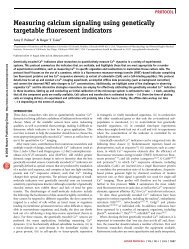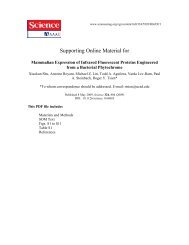THE GREEN FLUORESCENT PROTEIN - Tsien
THE GREEN FLUORESCENT PROTEIN - Tsien
THE GREEN FLUORESCENT PROTEIN - Tsien
Create successful ePaper yourself
Turn your PDF publications into a flip-book with our unique Google optimized e-Paper software.
<strong>GREEN</strong> <strong>FLUORESCENT</strong> <strong>PROTEIN</strong> 539made in calculating R 0 (102). If instead the mutual orientation of the twochromophores were the same as in the crystal structure for the wild-type dimer(31), the R 0 s would be about 72% of the previously calculated values, for example,35–37 Å for cyan-to-yellow FRET. For comparison, the actual distancer between the centers of the chromophores in the dimer is about 25 Å, whichwould predict that FRET would occur with about 90% efficiency in such a directheterodimer between cyan and yellow mutants.OUTLOOK FOR FUTURE RESEARCHDespite all that has been learned about how GFP works and how it can beexploited as a research tool, enormous challenges and opportunities remain.Listed below are some unanswered general questions about GFP that are amongthe most intriguing, excluding problems related to narrow applications in cellbiology:Cloning of Related GFPsWhat are the genetic sequences and structures of GFP homologs from bioluminescentorganisms other than Aequorea? This information would illuminatethe evolution of fluorescent proteins, reveal the essential conserved elementsof the structure, and provide the genetic raw material for combinatorial mixingand matching to produce hybrid proteins with new phenotypes. Renilla GFP isthe most obvious next cloning target, but even more bioluminescent organismsshould be investigated.Protein Folding and Chromophore FoldingWe need to know much more about how GFP folds into its β-barrel conformationand synthesizes its internal chromophore. Now that many of the stepshave been kinetically resolved (23), the effect of mutations on each of the stepsneeds to be determined. The most informative mutants will not be the majoritythat completely prevent the formation of fluorescence, because those could actanywhere in the entire cascade including disruption of the final state. Instead,mutants or chaperonins that affect the rates but not the final extent of fluorescencedevelopment are likely to be most valuable. The molecular mechanism,kinetics, and byproducts of chromophore formation by O 2 are particularly criticalquestions.Altered Wavelengths of FluorescenceYet longer wavelengths of excitation and emission than are currently availablefrom the class 4 (π-stacked phenolate) mutants (Table 1) would be useful formultiple labels and reporters and to serve as resonance energy transfer acceptors.






